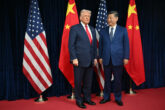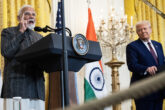August 20, 2019
What Would a Larger Chinese Presence Mean for the Middle East?
The Middle East has emerged as a new theater of U.S.-China great power competition. Today, America’s military presence in the region coupled with its strong diplomatic relationships provide Washington with potential leverage over Beijing. During a crisis or conflict originating in East Asia, Washington could use its military capabilities in the Middle East to hold at risk or even sever the sea lines of communication (SLOCs) linking China to some of its key markets and sources of energy imports.
However, China’s burgeoning presence in the Middle East is eroding this source of leverage. Under the umbrella of what it calls “One Belt, One Road,” Beijing is steadily expanding its political influence and investment footprint around regional maritime chokepoints, including the Suez Canal, the Bab el Mandeb, and the Strait of Hormuz. Commercial entanglement with Beijing could have strategic implications. Specifically, U.S. allies and partners in close proximity to these chokepoints could prove reluctant to allow American forces to operate against China-bound shipping from their territory or through their airspace.
Read the full article on ChinaFile.
More from CNAS
-
Indo-Pacific Security / Energy, Economics & Security
How to Win the Economic War with ChinaTrump's approach to China has run aground, giving Beijing unprecedented advantage in the economic conflict....
By Edward Fishman & Julian Gewirtz
-
America’s Self-Loathing Is a Losing Hand
This article was originally published in The Washington Post.Around 10 years ago, the United States began a historic shift in its grand strategy toward China, abandoning the b...
By David Feith
-
Indo-Pacific Security / Energy, Economics & Security / Technology & National Security
Selling AI Chips Won’t Keep China Hooked on U.S. TechnologyU.S. policy should not rest on the illusion that selling chips can trap China inside the American tech ecosystem....
By Janet Egan
-
Will New Delhi-Beijing Move Beyond Friction Points? | Ex-White Official On India-China Reset
Prime Minister Narendra Modi on Friday said that India and China, as two major economies, must work together to bring stability to the global economic order. NDTV's Gaurie Dwi...
By Lisa Curtis




